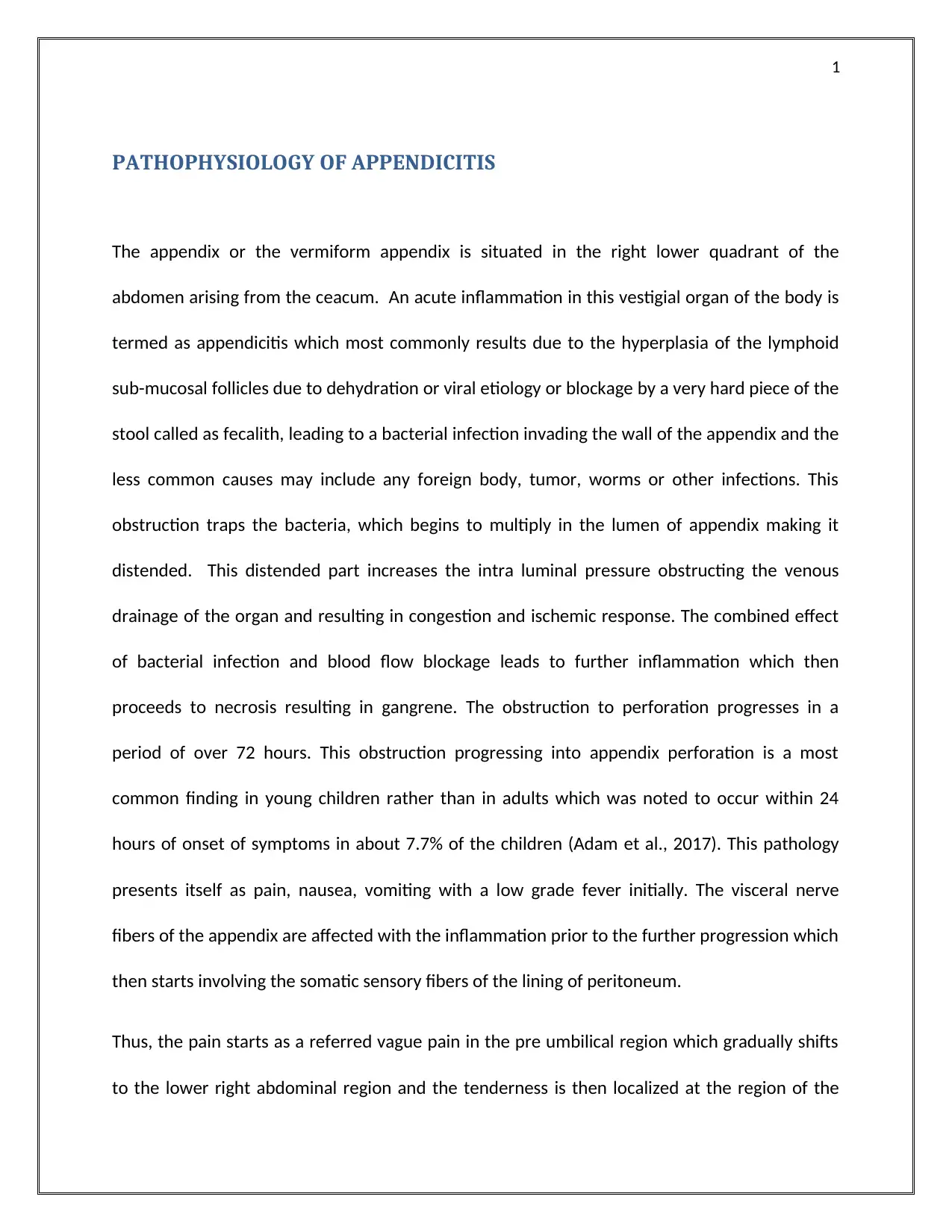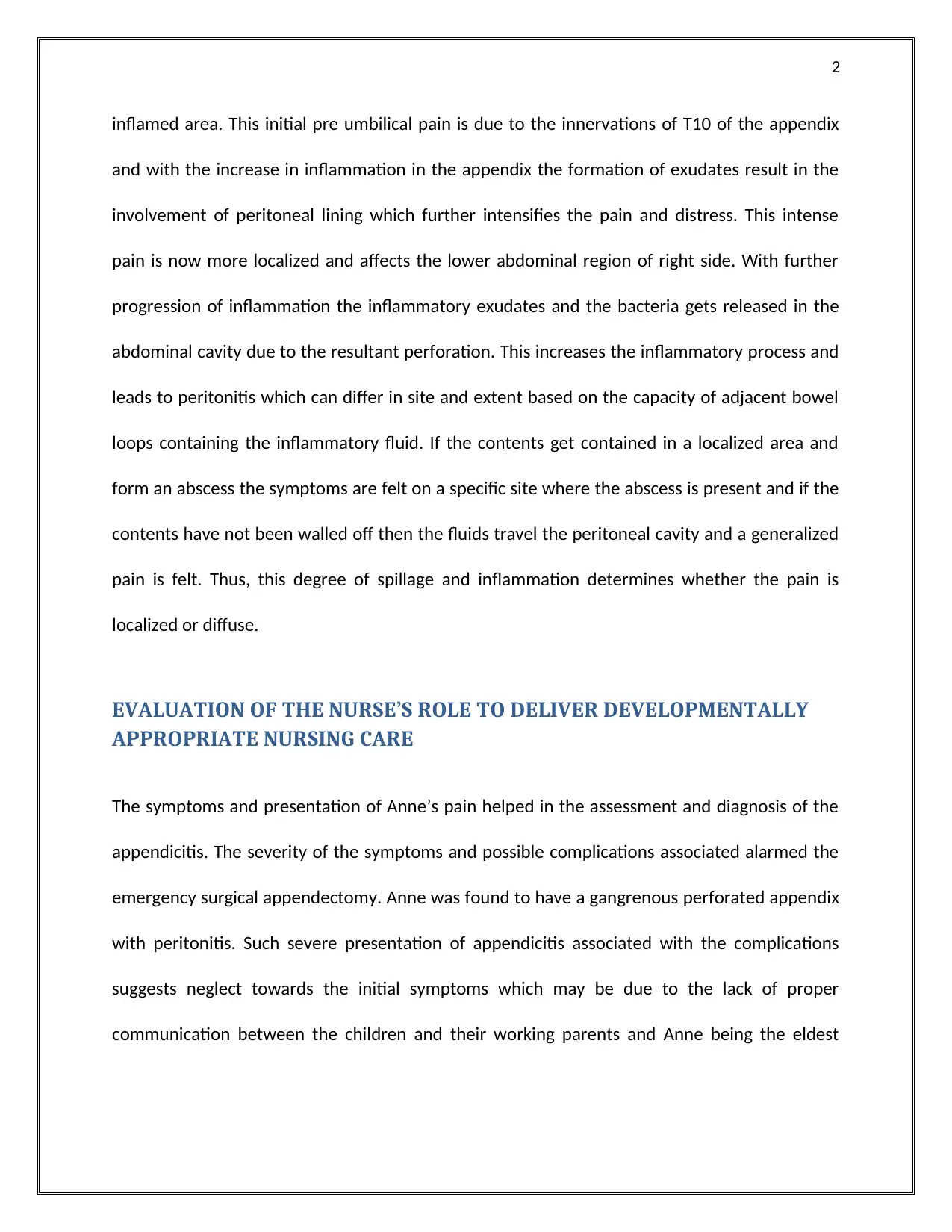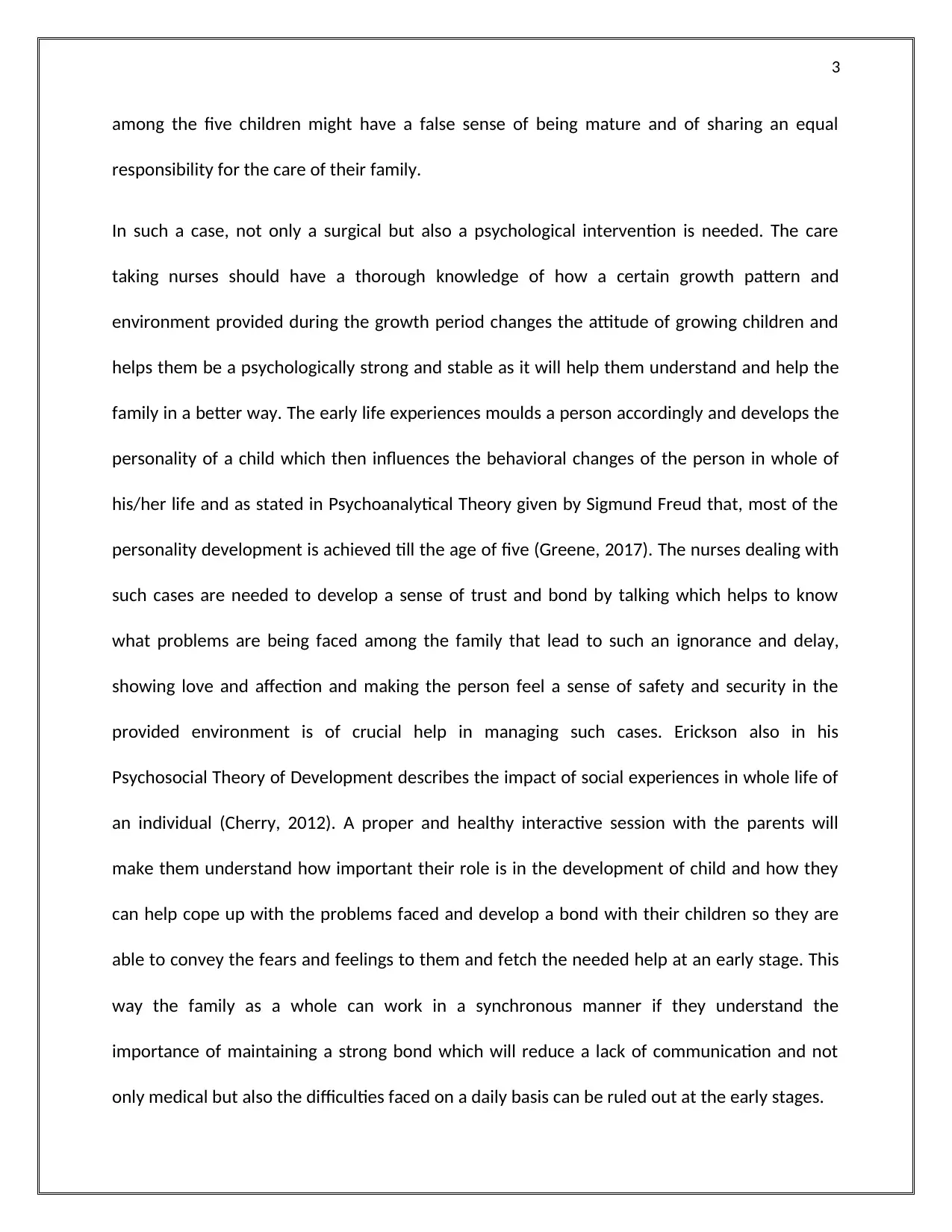Analysis of Appendicitis Pathophysiology and Nursing Intervention
VerifiedAdded on 2024/05/20
|4
|1053
|444
Case Study
AI Summary
This case study delves into the pathophysiology of appendicitis, focusing on the inflammatory processes leading to perforation and peritonitis. It highlights the importance of early diagnosis and intervention, as demonstrated by a patient presenting with a gangrenous perforated appendix. The study also evaluates the nurse's role in delivering developmentally appropriate care, emphasizing the need for psychological intervention alongside surgical treatment, especially in cases where delayed presentation suggests underlying family dynamics or communication issues. The significance of understanding child development theories, such as those of Freud and Erikson, is underscored to foster trust and effective communication, ultimately improving patient outcomes and family well-being. The case underscores the need for a holistic approach to patient care, addressing both the physical and psychological aspects of illness within the context of the patient's family and social environment. Desklib provides solved assignments and study resources for students.

1
PATHOPHYSIOLOGY OF APPENDICITIS
The appendix or the vermiform appendix is situated in the right lower quadrant of the
abdomen arising from the ceacum. An acute inflammation in this vestigial organ of the body is
termed as appendicitis which most commonly results due to the hyperplasia of the lymphoid
sub-mucosal follicles due to dehydration or viral etiology or blockage by a very hard piece of the
stool called as fecalith, leading to a bacterial infection invading the wall of the appendix and the
less common causes may include any foreign body, tumor, worms or other infections. This
obstruction traps the bacteria, which begins to multiply in the lumen of appendix making it
distended. This distended part increases the intra luminal pressure obstructing the venous
drainage of the organ and resulting in congestion and ischemic response. The combined effect
of bacterial infection and blood flow blockage leads to further inflammation which then
proceeds to necrosis resulting in gangrene. The obstruction to perforation progresses in a
period of over 72 hours. This obstruction progressing into appendix perforation is a most
common finding in young children rather than in adults which was noted to occur within 24
hours of onset of symptoms in about 7.7% of the children (Adam et al., 2017). This pathology
presents itself as pain, nausea, vomiting with a low grade fever initially. The visceral nerve
fibers of the appendix are affected with the inflammation prior to the further progression which
then starts involving the somatic sensory fibers of the lining of peritoneum.
Thus, the pain starts as a referred vague pain in the pre umbilical region which gradually shifts
to the lower right abdominal region and the tenderness is then localized at the region of the
PATHOPHYSIOLOGY OF APPENDICITIS
The appendix or the vermiform appendix is situated in the right lower quadrant of the
abdomen arising from the ceacum. An acute inflammation in this vestigial organ of the body is
termed as appendicitis which most commonly results due to the hyperplasia of the lymphoid
sub-mucosal follicles due to dehydration or viral etiology or blockage by a very hard piece of the
stool called as fecalith, leading to a bacterial infection invading the wall of the appendix and the
less common causes may include any foreign body, tumor, worms or other infections. This
obstruction traps the bacteria, which begins to multiply in the lumen of appendix making it
distended. This distended part increases the intra luminal pressure obstructing the venous
drainage of the organ and resulting in congestion and ischemic response. The combined effect
of bacterial infection and blood flow blockage leads to further inflammation which then
proceeds to necrosis resulting in gangrene. The obstruction to perforation progresses in a
period of over 72 hours. This obstruction progressing into appendix perforation is a most
common finding in young children rather than in adults which was noted to occur within 24
hours of onset of symptoms in about 7.7% of the children (Adam et al., 2017). This pathology
presents itself as pain, nausea, vomiting with a low grade fever initially. The visceral nerve
fibers of the appendix are affected with the inflammation prior to the further progression which
then starts involving the somatic sensory fibers of the lining of peritoneum.
Thus, the pain starts as a referred vague pain in the pre umbilical region which gradually shifts
to the lower right abdominal region and the tenderness is then localized at the region of the
Paraphrase This Document
Need a fresh take? Get an instant paraphrase of this document with our AI Paraphraser

2
inflamed area. This initial pre umbilical pain is due to the innervations of T10 of the appendix
and with the increase in inflammation in the appendix the formation of exudates result in the
involvement of peritoneal lining which further intensifies the pain and distress. This intense
pain is now more localized and affects the lower abdominal region of right side. With further
progression of inflammation the inflammatory exudates and the bacteria gets released in the
abdominal cavity due to the resultant perforation. This increases the inflammatory process and
leads to peritonitis which can differ in site and extent based on the capacity of adjacent bowel
loops containing the inflammatory fluid. If the contents get contained in a localized area and
form an abscess the symptoms are felt on a specific site where the abscess is present and if the
contents have not been walled off then the fluids travel the peritoneal cavity and a generalized
pain is felt. Thus, this degree of spillage and inflammation determines whether the pain is
localized or diffuse.
EVALUATION OF THE NURSE’S ROLE TO DELIVER DEVELOPMENTALLY
APPROPRIATE NURSING CARE
The symptoms and presentation of Anne’s pain helped in the assessment and diagnosis of the
appendicitis. The severity of the symptoms and possible complications associated alarmed the
emergency surgical appendectomy. Anne was found to have a gangrenous perforated appendix
with peritonitis. Such severe presentation of appendicitis associated with the complications
suggests neglect towards the initial symptoms which may be due to the lack of proper
communication between the children and their working parents and Anne being the eldest
inflamed area. This initial pre umbilical pain is due to the innervations of T10 of the appendix
and with the increase in inflammation in the appendix the formation of exudates result in the
involvement of peritoneal lining which further intensifies the pain and distress. This intense
pain is now more localized and affects the lower abdominal region of right side. With further
progression of inflammation the inflammatory exudates and the bacteria gets released in the
abdominal cavity due to the resultant perforation. This increases the inflammatory process and
leads to peritonitis which can differ in site and extent based on the capacity of adjacent bowel
loops containing the inflammatory fluid. If the contents get contained in a localized area and
form an abscess the symptoms are felt on a specific site where the abscess is present and if the
contents have not been walled off then the fluids travel the peritoneal cavity and a generalized
pain is felt. Thus, this degree of spillage and inflammation determines whether the pain is
localized or diffuse.
EVALUATION OF THE NURSE’S ROLE TO DELIVER DEVELOPMENTALLY
APPROPRIATE NURSING CARE
The symptoms and presentation of Anne’s pain helped in the assessment and diagnosis of the
appendicitis. The severity of the symptoms and possible complications associated alarmed the
emergency surgical appendectomy. Anne was found to have a gangrenous perforated appendix
with peritonitis. Such severe presentation of appendicitis associated with the complications
suggests neglect towards the initial symptoms which may be due to the lack of proper
communication between the children and their working parents and Anne being the eldest

3
among the five children might have a false sense of being mature and of sharing an equal
responsibility for the care of their family.
In such a case, not only a surgical but also a psychological intervention is needed. The care
taking nurses should have a thorough knowledge of how a certain growth pattern and
environment provided during the growth period changes the attitude of growing children and
helps them be a psychologically strong and stable as it will help them understand and help the
family in a better way. The early life experiences moulds a person accordingly and develops the
personality of a child which then influences the behavioral changes of the person in whole of
his/her life and as stated in Psychoanalytical Theory given by Sigmund Freud that, most of the
personality development is achieved till the age of five (Greene, 2017). The nurses dealing with
such cases are needed to develop a sense of trust and bond by talking which helps to know
what problems are being faced among the family that lead to such an ignorance and delay,
showing love and affection and making the person feel a sense of safety and security in the
provided environment is of crucial help in managing such cases. Erickson also in his
Psychosocial Theory of Development describes the impact of social experiences in whole life of
an individual (Cherry, 2012). A proper and healthy interactive session with the parents will
make them understand how important their role is in the development of child and how they
can help cope up with the problems faced and develop a bond with their children so they are
able to convey the fears and feelings to them and fetch the needed help at an early stage. This
way the family as a whole can work in a synchronous manner if they understand the
importance of maintaining a strong bond which will reduce a lack of communication and not
only medical but also the difficulties faced on a daily basis can be ruled out at the early stages.
among the five children might have a false sense of being mature and of sharing an equal
responsibility for the care of their family.
In such a case, not only a surgical but also a psychological intervention is needed. The care
taking nurses should have a thorough knowledge of how a certain growth pattern and
environment provided during the growth period changes the attitude of growing children and
helps them be a psychologically strong and stable as it will help them understand and help the
family in a better way. The early life experiences moulds a person accordingly and develops the
personality of a child which then influences the behavioral changes of the person in whole of
his/her life and as stated in Psychoanalytical Theory given by Sigmund Freud that, most of the
personality development is achieved till the age of five (Greene, 2017). The nurses dealing with
such cases are needed to develop a sense of trust and bond by talking which helps to know
what problems are being faced among the family that lead to such an ignorance and delay,
showing love and affection and making the person feel a sense of safety and security in the
provided environment is of crucial help in managing such cases. Erickson also in his
Psychosocial Theory of Development describes the impact of social experiences in whole life of
an individual (Cherry, 2012). A proper and healthy interactive session with the parents will
make them understand how important their role is in the development of child and how they
can help cope up with the problems faced and develop a bond with their children so they are
able to convey the fears and feelings to them and fetch the needed help at an early stage. This
way the family as a whole can work in a synchronous manner if they understand the
importance of maintaining a strong bond which will reduce a lack of communication and not
only medical but also the difficulties faced on a daily basis can be ruled out at the early stages.
⊘ This is a preview!⊘
Do you want full access?
Subscribe today to unlock all pages.

Trusted by 1+ million students worldwide

4
REFERENCES
Cherry, K. (2012). Erikson's theory of psychosocial development psychosocial
development in infancy and early childhood. The New York Times Company.
http://psychology. about. com/od/psychosocialtheories/a/psychosocial. htm [26 May
2012].[Links].
Ewen, R. (2014). An introduction to theories of personality. Psychology Press.
Greene, R. (2017). Human behavior theory: A diversity framework. Routledge
Alder, A. (2017) Pediatric Appendicitis (Online) available at
https://emedicine.medscape.com/article/926795-overview last accessed on 16/03/2018
REFERENCES
Cherry, K. (2012). Erikson's theory of psychosocial development psychosocial
development in infancy and early childhood. The New York Times Company.
http://psychology. about. com/od/psychosocialtheories/a/psychosocial. htm [26 May
2012].[Links].
Ewen, R. (2014). An introduction to theories of personality. Psychology Press.
Greene, R. (2017). Human behavior theory: A diversity framework. Routledge
Alder, A. (2017) Pediatric Appendicitis (Online) available at
https://emedicine.medscape.com/article/926795-overview last accessed on 16/03/2018
1 out of 4
Related Documents
Your All-in-One AI-Powered Toolkit for Academic Success.
+13062052269
info@desklib.com
Available 24*7 on WhatsApp / Email
![[object Object]](/_next/static/media/star-bottom.7253800d.svg)
Unlock your academic potential
Copyright © 2020–2025 A2Z Services. All Rights Reserved. Developed and managed by ZUCOL.





